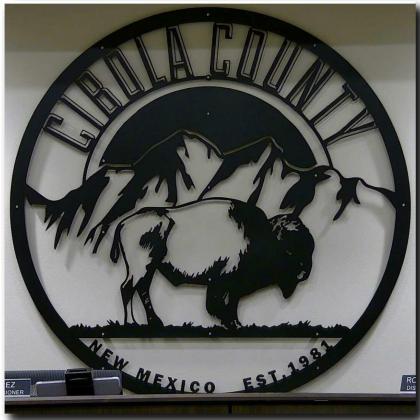CIBOLA COUNTY, N.M. — The American Bison species has undergone a long and unfavorable journey in New Mexico and the United States. From a thriving population to the brink of extinction, to a modest recovery and comeback, there were many factors that contributed to the downfall of the bison and where they are today.
First off, many people often confuse bison for buffalo, using the terms interchangeably. The truth, however, is that while two are a part of the same family, they are not closely related. According to https://nationalzoo.si.edu/animals/news/its-bison-not-buffalo-and-other-american-bison-facts, the “true” buffalo, which are cape buffalo and water buffalo, originated in Africa and Asia, while the bison are from North America and Europe. It is the bison that have been known to roam the wide-open plains of North America, and even New Mexico. At one point, in
At one point, in the 1600’s, about 60 million bison have been estimated to have inhabited North America, reported https://allaboutbison.com/bison-in-history/bison-timeline/. As the years went by, history unfolded and so did the effects of Spanish settlers entering areas such as New Mexico. The downfall of the bison began in the 1800’s when a new drought began. Then, with Spanish settlers also came new livestock: horses. According to https://www.nps.gov/articles/000/what-happened-to-the-bison.htm, the entrance of the horse population “stressed bison populations,” took away resources from the bison, and made it easier for humans to hunt the bison.
Native Americans relied on bison hunting for food and materials, especially during relocation and colonization periods imposed by White settlers. As time passed, the settlers saw the bison population as getting in the way of colonization of the Native American tribes due to them inhabiting desired reservation territories, so bison hunting was pushed even harder, leading to their near extinction.
What saved the bison was officials at Yellowstone National Park taking in the last wild and pure herd, helping to maintain the population of the bison even today. Slowly but surely, the bison population has gradually recovered; the population is nowhere near where it was, but government measures, initiatives, and programs have since been created to continue protecting and developing the bison population.
As far as New Mexico is concerned, there are not currently any wild bison herds here, but there are a few privately owned bison ranches that possess private herds protected in fenced areas. Some of these include the Beck & Bulow Ranch near Las Vegas, Vermejo Park Ranch in Raton, Spahn & Friends Bison Ranch in Raton, The Ladder Ranch in Caballo, and possibly more. Some of these ranches facilitate controlled bison hunts when environmental conditions permit.
Cibola County has a special connection to the bison, or buffalo, as settlers mistakenly called it, in the way that the county’s official seal contains the image of a bison/“buffalo”. According to a program from Cibola County’s opening ceremony on June 19, 1981, “This may be the earliest NM place name to appear on a map, since it is shown on Castillo’s map in 1541…. Frederick Webb Hodge points out that Fray Marcos learned the name in the language of one of the Piman tribes of northern Sonora or southern Arizona, and he ventures the suggestion that CIBOLA may be a transliteration of SHIWINA, the Zuni name for their tribal range. Fray Escobar, in his diary of the Onate expedition to California, 1605, says the Spaniards called the Zuni pueblo of Hawikuh by the name of Scibola. This place name was transferred in Spanish to the great animal native to the region, the buffalo (Bison Americanus). Castenada describes the Seven Cities as “seven little villages… all within a radius of four leagues… together they are called the kingdom of Cibola.” (Narrative of the Coronado Expedition, eds. Hammond and Rey, 1940). Clevel Hallenbeck, annotating his translation, The Journey of Fray Marcos (1949), p. 87, says that the Isleta Indians have a world (sic.) si-bu-la-da, meaning “buffalo,” that may have been learned from the Aztec term for the animal.” Considering the
Considering the incredible number of bison roaming North America during the 1500’s and 1600’s, and based on the expedition journals referenced in Cibola County’s opening ceremony program, it is safe to assume that the bison must have inhabited the Cibola County area at one point in the distant past, and the county still holds that piece of history close today. The American Bison went through quite the journey to reach where the population is at currently, but one thing that is for certain – they still have the effect of leaving anyone who is lucky enough to witness them in their natural habitat on the open plains in awe of their natural beauty here on Earth.

